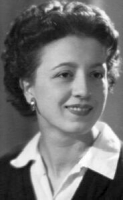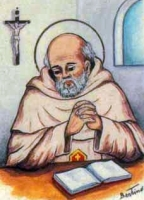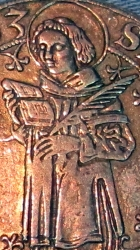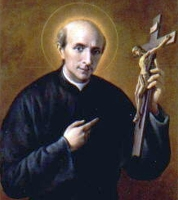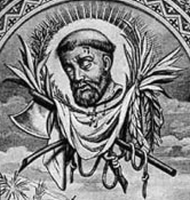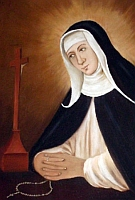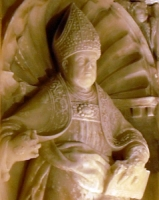St. Parmenas
Died 98
Philippi, Macedonia
Venerated in Roman Catholic Church, Orthodox Church
Feast 23 January
One of the seven deacons appointed by the Apostles to minister to the Hellenized Jews of Jerusalem who had converted to the Christian faith. Their labors were reported in the Acts of the Apostles. Parmenas is said to have to have spent many years preaching in Asia Minor before receiving martyrdom in Philippi, Macedonia, under Emperor Trajan.
Parmenas (Greek: Παρμενᾶς) was one of the Seven Deacons. He is believed to have preached the gospel in Asia Minor. Parmenas suffered martyrdom in 98, under the persecution of Trajan. He is one of the 4 out of 7 deacons jointly celebrated on July 28th.
Christian tradition identifies him as the Bishop of Soli. Some take this to be Soli, Cyprus, while others interpret it as Soli, Cilicia
St. John the Almoner
தான தர்மங்கள் செய்த தூய யோவான் (ஜனவரி 23)
தூய யோவான் (John the Almsgiver) தான தர்மங்களில் மிகவும் சிறந்து விளங்கியதற்கு காரணமாக அமைந்ததாகச் சொல்லப்படும் நிகழ்வு.
ஒரு சமயம் அவர் ஆலயத்தில் அமர்ந்து ஜெபித்துக்கொண்டிருந்தபோது பெண் ஒருவர் காட்சி தந்தார். பிற்காலத்தில்தான் தெரிந்தது அந்தப் பெண் வேறுயாருமல்ல அன்னை மரியாள் என்று. அவர் யோவானிடம், “நான்தான் விண்ணகத் தந்தையின் மூத்த மகள். என்மீது நீ பக்திகொண்டு, தான தர்மங்களைச் செய்து வந்தால், நான் உன்னை இயேசு கிறிஸ்துவுக்கு மிக நெருக்கமாக அழைத்துச் செல்வேன்” என்றார். அந்தப் பெண் – அன்னை மரியா - சொன்னதற்கிணங்க யோவான் ஏழை எளிய மக்களுக்கு தான தர்மங்களை வழங்கி வந்தார். அதனால் அவர் பிற்காலத்தில் புனிதராகும் பேறு பெற்றார்.
வாழ்க்கை வரலாறு
யோவான் 550 ஆம் ஆண்டினை ஒட்டி எபிபெனயுஸ் என்பவருக்கு மகனாகப் பிறந்தார். பிற்காலத்தில் இவர் வளர்ந்து சைப்ரசின் ஆளுநராக உயர்ந்தார். மனைவி மக்கள் என்று இவர் மிகவும் சந்தோசமாக வாழ்ந்துகொண்டிருந்தபோது திடிரென்று ஒருநாள் இவருடைய மனைவியும் பிள்ளைகளும் இறந்து போனார்கள். இதனால் வாழ்க்கையை வெறுத்துப் போன யோவான் எல்லாவற்றையும் துறந்து, குருமடத்தில் சேர்ந்து குருவாக மாறினார். ஒருசில ஆண்டுகளில் இவர் அலெக்ஸ்சாந்திரிய நகரின் ஆயராக உயர்ந்தார்.
இவர் அலெக்ஸ்சாந்திரியா நகரின் ஆயராக உயர்ந்த பின்னர் ‘நிபந்தனை இன்றி தான தர்மங்கள் செய்வது’ என்பதை விருதுவாக்காக எடுத்துக்கொண்டு தேவையில் இருக்கின்ற எல்லாருக்கும் உதவி செய்திட திட்டம் தீட்டினார். அதற்காக அவர் நகரில் இருந்த ஏழை எளியவர்களுடைய பட்டியலைத் தயாரித்தார். வாரத்தில் புதன் மற்றும் வெள்ளிக்கிழமையை அவர்களுக்காக ஒதுக்கி அவர்களுடைய வாழ்வு ஏற்றம் பெற அவர் கடுமையாக உழைத்தார்.
யோவான் ஏழை எளியவர்மீது மட்டுமல்லாமல் நோயாளிகள்மீதும் அதிக அன்பும் அக்கறையும் காட்டி வந்தார். வீட்டில் இருந்த நோயாளிகளையும் மருத்தவமனையில் இருந்த நோயாளிகளையும் சந்தித்து, அவர்களிடம் ஆறுதலாகப் பேச அவர் தவறியதே இல்லை. யோவானிடம் இருந்த மற்றொரு சிறப்பான குணம் அவர் எல்லாரையும் சமமாகவே பார்ப்பதுதான். இதனால் அவரை யாரும் எந்த நேரத்திலும் எளிதாய் அணுகி வரக்கூடிய சூழ்நிலை ஏற்பட்டது. இவ்வாறு ஏழைக்குப் பங்களானாக வாழ்ந்து வந்த யோவான் பெர்சிய நாட்டுப் படை அலெக்ஸ்சாந்திரியாவின் மீது படையெடுத்து வந்தபோது அதில் அவர் நாடுகடத்தப் பட்டு சைப்ரசிற்கு கொண்டு செல்லப்பட்டார். அங்கே அவர் 614 ஆம் ஆண்டு நோய் வாய்ப்பட்டு இறந்துபோனார்.
Born c. 552
Amathus, Cyprus
Died c. 616–620
Cyprus
Venerated in Eastern Orthodoxy
Catholic Church
Oriental Orthodoxy
Canonized Pre-Congregation
Major shrine San Giovanni Elemosinario, Venice, Italy
Feast 12 November (Orthodox)
23 January (Roman Catholic)
11 November (Coptic Orthodox)
Attributes Bishop vestment
Miter
Crosier
Patronage Egypt
Patriarch of Alexandria, Egypt, called "the Almoner" because of his generosity to the poor. He was born into a noble family of Cyprus and was briefly married. When his wife and child died, he entered the religious life, and in 608 was named patriarch of Alexandria. He aided refugees from the Persian assaults on the Holy Land and built charitable institutions. John predicted his own death. He had to leave Alexandria when a Persian invasion troubled the region and had a vision of his demise. John went to Amathus, on Cyprus, where he died on November 11.
John the Merciful (Greek: Ἰωάννης ὁ Ἐλεήμων, romanized: Iōannēs ho Eleēmōn), also known as St John the Almsgiver, John the Almoner, John V of Alexandria, John Eleymon, and Johannes Eleemon, was the Chalcedonian Patriarch of Alexandria in the early 7th century (from 606 to 616) and a Christian saint. He is the patron saint of Casarano, Italy and of Limassol, Cyprus.
Early life
He was born at Amathus as the son of Epiphanius, governor of Cyprus, and was of noble descent. In early life he was married and had children, but his wife and children soon died, after which he entered religious life.
On the death of the Patriarch Theodore, the Alexandrians besought Emperor Phocas to appoint John his successor, which was accordingly done. One of the first steps he took was to make a list of several thousand needy persons, whom he took under his especial care. He always referred to the poor as his "lords and masters", because of their mighty influence at the Court of the Most High. He assisted people of every class who were in need.
He was a reformer who attacked simony, and fought heresy by means of improvements in religious education. He also reorganized the system of weights and measures for the sake of the poor, and put a stop to corruption among the officials.[1] He increased the number of churches in Alexandria from seven to seventy.
The ministry of Vitalis of Gaza, a monk who worked among the prostitutes of the city, was a noteworthy episode of John's reign. The patriarch was considered to have behaved with wisdom for not punishing this monk who was notorious for visiting the seedy part of town, and his judgment was vindicated only after the death of Vitalis when the story of the monk's mission of mercy became known.[2]
In his youth John had had a vision of a beautiful maiden with a garland of olives on her head, who said that she was Compassion, the eldest daughter of the Great King. This had evidently made a deep impression on John's mind, and, now that he had the opportunity of exercising benevolence on a large scale, he soon became widely known all over the East for his liberality towards the poor.
A shipwrecked merchant was thus helped three times, on the first two occasions apparently without doing him much good; the third time however, John fitted him out with a ship and a cargo of wheat, and by favourable winds he was taken as far as Britain, where, as there was a shortage of wheat, he obtained his own price.[3]
Another person, who was not really in need, applied for alms and was detected by the officers of the palace; but John merely said "Give unto him; he may be Our Lord in disguise." He visited the hospitals three times every week, and he freed a great many slaves. John is said to have devoted the entire revenues of his see to the alleviation of those in need. A rich man presented him with a magnificent bed covering; he accepted it for one night, but then sold it, and disposed of the money in alms. The rich man "bought in" the article, and again presented it to John, with the same result. This was repeated several times; but John drily remarked: "We will see who tires first."[4]
Another instance of his piety was that he caused his own grave to be dug, but only partly so, and appointed a servant to come before him on all state occasions and say "My Lord, your tomb is unfinished; pray give orders for its completion, for you know not the hour when death may seize you." When the Sassanids sacked Jerusalem in 614, John sent large supplies of food, wine, and money to the fleeing Christians. But eventually the Persians occupied Alexandria, and John himself in his old age was forced to flee to his native country, where he died.
John died in Cyprus somewhere between 616 and 620.
From Cyprus his body was moved to Constantinople, then in 1249 to Venice, where there is a church dedicated to him, the Chiesa di San Giovanni Elemosinario, although his relics are preserved in another church, San Giovanni in Bragora, in a separate chapel.
Another relic of him was sent by Sultan Bayezid II in 1489 to King Matthias Corvinus of Hungary. It was placed in the private Royal Chapel in Buda Castle, which was dedicated to him. Now his body lies in the St. John the Merciful Chapel in St. Martin's Cathedral in Bratislava, Slovakia.
A church in Cospicua, Malta, is dedicated to him, and one of the bastions of the Santa Margherita Lines in the same city is also named after him
St. Abakuh
Feastday: January 23
Abakuh (also known as Apa Kauh), another martyr of the Christian church. He was born at Bamujeh in the Al Fayyum area of Egypt. He was a zealous Christian who was martyred for his Christianity with eight companions. His feast day is January 23. He is referenced in the Synaxaire Arabe-Jacobite
Espousal of the Blessed Virgin Mary
Article
Feast in honor of the Blessed Virgin's espousal to Saint Joseph. It dates from 1517 when it was granted to the nuns of the Annunciation by Pope Leo X with nine other Masses in honor of Our Lady. Adopted by many religious orders and dioceses, it was observed for a time by nearly the whole Church, but is no longer in the Calendar. It is the subject of a famous painting by Raphael and Viterbo.
Blessed Benedetta Bianchi Porro
Also known as
Bianchi Porro
Profile
Daughter of Guido Bianchi Porro and Elsa Giammarchi, the second of six children. Afflicted with poliomyelitis at an early age, leaving her with a crippled left leg and a need to wear a brace to prevent her spine from deforming. A clever and happy child, she began keeping a diary at age five; it became a lifelong record of her faith and the way she carried the cross of her disability. Much of her primary education was provided by Ursulines. In her teens she began to lose her hearing, and her overall health continued to deterioate.
At age 17 she enrolled in the University of Milan, Italy with a plan to study physics, but later changed to medicine. Some teachers objected to having a pre-med student who was so deaf that had to have written questions during an oral eximation, but Benedetta was an excellent student. In 1957 her studies had reached a point that she was able to diagnose herself; she had Recklinghausen Disease-Neuro-Fibromatosis which leads to paralysis of the nervous system. She had surgery in 1958 to treat part of the condition, but it was of little benefit, and left the left side of her face paralysed. She continued her studies, but in 1959 she began losing the sense of touch, taste and smell, was completely deaf, and had to give up the idea of a medical career.
Benedetta had further surgery in August 1959; it left both legs paralyzed, and the young woman wheelchair bound. She then turned her sick room into a center of support and communication for others. Her friends from medical school were frequent visitors, and she began correspondences; in person or in print she was uniformly optimistic about life and the love of God. Benedetta and her family visited Lourdes in May 1962 in search of a cure; a paralyzed girl lying next to her was completely healed, but there was no change for Benedetta.
In Milan on 27 February 1963 Benedetta had another operation; it left her blind. She could barely speak, and could only move her right hand. However, the number of her visitors increased as word of her holiness and her gentle understanding of to love God even these circumstances. On 24 June 1963 she went again to Lourdes; as her family waited for her to be healed, she received her own miracle – the understanding that she would not change a thing about her condition.
Born
8 August 1936 at Dovádola, Forli, Italy
Died
• 23 January 1964 at Sirmione, Italy of complications resulting from her Recklinghausen DiseaseNeuro-Fibromatosis
• buried in the cemetery at Sirmione
• body later transferred to a sarcophagus in the Benedictine Church of Saint Andrew, Dovadola, Italy
Beatified
• 14 September 2019 by Pope Francis
• beatification recognition celebrated at the Cathedral of Santa Croce in Forlì, Italy, presided by Cardinal Giovanni Angelo Becciu
Saint Maimbod
Also known as
Mainbeouf, Mainbodo
Profile
Wandering missionary who made pilgrimages to tombs of saints and martyrs throughout Gaul and northern Italy, preaching to those he met on the way.
Born
Irish
Died
• c.880 in Kaltenbrunn, Alsace, Gaul (modern France)
• there are two stories of his death
• he was martyred by pagans while preaching to them
• a Burgundian nobleman gave Maimbod a gift of a fine pair of gloves as a reminder to pray for him; while Mainbod was praying at the church of Domnipetra, he was attacked by thieves who thought he had money because of the gloves
• buried at the church of Domnipetra, Kaltenbrunn, Alsace, Gaul
• miracles reported at his tomb, and during the translation of his relics
• Count Aszo of Monteliard asked the blind bishop Berengarius for a gift of the saint's relics; during the move, Berengarius miraculously recovered his sight, and he instituted the feast in honor of Mainbod
• relics destroyed in the 16th century
Canonized
c.900
Saint Emerentiana
புனித_எமரண்டியனா (-304)
ஜனவரி 23
இவர் (#StEmerentiana) உரோமையைச் சார்ந்தவர். புனித ஆக்னசின் சகோதரி.
மக்களுக்கு மறைக்கல்வியைக் கற்றுக்கொடுத்து வந்தவரான இவர், புனித ஆக்னசின் இறப்பிற்குப் பிறகு அவரது கல்லறையில் வேண்டுவதற்காகச் சென்றனர்.
அப்பொழுது சிலர் இவர் ஆக்னசின் சகோதரி என்றும், கிறிஸ்தவள் என்றும் அறிந்து இவரைக் கல்லால் எறிந்து கொன்றனர். இவ்வாறு இவர் ஆண்டவர் இயேசுவின்மீது கொண்ட நம்பிக்கைக்காகத் தம் இன்னுயிரைத் துறந்தார்.
இவரிடம் வேண்டிக் கொண்டால் வயிற்று வலி நீங்கும் என்றொரு நம்பிக்கை இருக்கிறது.
Also known as
Emerentia
Profile
Foster-sister of Saint Agnes of Rome. Catechumen. While on her way to pray at Saint Agnes's grave a few days after her sister's martyrdom, she was confronted by an angry mob of pagans. Emerentiana professed her Christianity and her relationship to Agnes. Martyr.
Born
Roman
Died
• stoned to death c.304 at Rome, Italy
• buried in the cemetery at Via Nomentana
• relics later translated to the Basilica of Saint Agnes
Patronage
• against abdominal pains
• against colic
• against stomach ache
Representation
• girl with stones in her lap and holding a palm of martyrdom or lily of a holy death
• girl being stoned by a mob near the tomb of Saint Agnes of Rome
Saint Ildephonsus of Toledo
Also known as
Ildefonso, Ildefonsus
Profile
Born to the Spanish nobility. Nephew of Saint Eugene of Toledo. Studied at Seville, Spain under Saint Isidore of Seville. Monk at Agli (Agalia) on the River Tagus near Toledo, Spain while still a young man. Abbot at Agli. Attended the Council of Toledo in 653 and 655. Archbishop of Toledo in 657. Responsible for the unification of the Spanish liturgy. Noted writer, especially on Our Lady; only four of his works have survived. Reported to have received an apparition of the Virgin Mary during which she presented him with a chalice.
Born
607 at Toledo, Spain
Died
667 of natural causes
Patronage
San Ildefonso Indian Pueblo
Blessed Margaret of Ravenna
Also known as
• Margaret Molli
• Margarita, Margherita, Marguerite
Profile
Nearly blind. Pious youth, given to severe, self-imposed austerities. She attracted followers, and founded a religious community of men and women. She wrote a separate rule for the community, but the group did not survive her death, the members joining other, established groups.
Born
8 May 1442 at Russi, Ravenna, Italy
Died
23 January 1505 at Ravenna, Italy of natural causes
Beatified
never formally beatified or canonized, but a popular devotion developed soon after her death, the devotees referring to her as Blessed
Saint Andreas Chong Hwa-Gyong
Also known as
• Andeurea Jeong Hwa-Gyeong
• Andrea Tyong Hwa-Gyong
Additional Memorial
20 September as one of the Martyrs of Korea
Profile
Layman catechist in the the apostolic vicariate of Korea. Assistant to Saint Lawrence Imbert. Turned his home into a safe-house for Christians hiding from official persecutions, for which he was shot, arrested and finally executed. Martyr.
Born
1808 in Cheongsan, Chungcheong-do, South Korea
Died
strangled on 23 January 1840 in prison at Seoul, South Korea
Canonized
6 May 1984 by Pope John Paul II
Saint Dositheus of Gaza
Profile
Born a rich pagan, Dositheus spent a wild and worldly youth. During a visit to Jerusalem he was so impressed by Christians, by an horrific image of the torments of hell, and by the message of a woman he saw in a vision, he converted, and became a monk at Gaza. He was placed under the direction of Saint Dorotheus the Younger, who had a long and steady struggle to teach Dositheus discipline, and take him from his worldly ways. Dositheus learned, changed, and became known for his gentle and supportive ways with the sick. When he became too ill to care for other sick people, he prayed that God would relieve him of his life, and soon after, he died quietly in his sleep.
Died
c.530 of a respiratory problem, possibly tuberculosis
Saint Asclas of Antinoe
Profile
Arrested and tortured for his faith by order of Arrian, governor of Egypt, during the persecutions of Diocletian. While Asclas was in prison, Arrian had reason to cross the River Nile on government business - but found he was absolutely unable to leave the water's edge. Asclas sent word that the governor would never be able to cross the river until he acknowledged Christ in writing. Arrian wrote out the statement, and was promptly able to leave the river bank. He crossed the Nile, and the moment he was on the other side, he ordered that Asclas be tortured and drowned. Martyr.
Born
Thebaid, Egypt
Died
drowned in the River Nile at Antinoe, Egypt c.287
Saint Lufthild
Also known as
Lufthildis
Profile
Abused by a jealous step-mother for her kindness to the poor, Lufthild left home young to live as an often-homeless hermit in and around Cologne, Germany.
Died
c.850
Canonized
• Pre-Congregation
• cultus confirmed by Archbishop Ferdinand von Wittelsbach of Cologne in 1623
Patronage
• child abuse victims
• hoboes
• homeless people
• tramps
Saint Messalina of Foligno
Profile
Spiritual student of Saint Felician of Foligno. Nun, receiving the veil from Saint Felician. During a period of persecution, Felician was imprisoned; when she visited him, Messalina was suspected of being a Christian. She was arrested, put on trial and ordered to sacrifice to pagan gods; she refused. Martyr.
Died
• beaten to death in 251
• relics re-discovered in 1599
•relics enshrined in the chapel of Our Lady of Loreto in the cathedral of Foligno, Italy
Abel the Patriarch
Article
Old Testament patriarch. Second son of Adam and Eve, slain by his brother Cain because the latter's oblation was not accepted favourably by God as was Abel's. For his death in this way he is regarded as a type of Our Saviour. His death symbolizes, too, the bloody sacrifice of the Cross and the unbloody one of the altar. He is mentioned in the Canon of the Mass, and his name holds first place in the Litany for the Dying.
Blessed Joan Font Taulat
Also known as
Brother Arnal Ciril
Profile
Member of the Brothers of the Christian Schools. Martyred in the Spanish Civil War.
Born
1 July 1890 in Viladamat, Girona, Spain
Died
23 January 1937 in Lleida, Spain
Beatified
• 13 October 2013 by Pope Francis
• beatification celebrated in Tarragona, Spain
Saint Agathangelus
Profile
Adult convert to Christianity, baptized by Saint Clement of Ancyra. Deacon. Evangelized in Ancyra (in modern Turkey) with Saint Clement, and was martyred with him.
Born
Roman
Died
• martyred in 309 in Ancyra (in modern Turkey)
• relics returned to Paris, France by Crusaders in the 13th century
Blessed Juan Infante
Profile
Mercedarian priest. With Blessed Juan Solorzano and Venerable Jorge of Seville, Blessed Juan accompanied Christopher Columbus on his second voyage to the Americas, and was the first celebrate Mass in South America.
Saint Jurmin
Profile
Prince. Relative of King Anna of East Anglia, England. Brother of Saint Etheldreda. Confessor of the faith.
Born
England
Died
• 653 of natural causes
• interred originally at Blythburgh, Suffolk, England
• relics enshrined at Bury Saint Edmunds in 1095
Saint Clement of Ancyra
Profile
Fourth-century bishop of Ancyra in Galatia, Asia Minor. Martyred in the persecutions of Diocletian and Maximinian.
Died
• 303
• relics later taken to Constantinople
• Crusaders later took the relics to western Europe
Saint Ormond of Mairé
Also known as
Armand
Profile
Monk. Abbot of the monastery of Saint Mairé in France, c.587. He supported monastic expansion and evangelization in his region.
Born
French
Died
6th century
Saint Colman of Lismore
Profile
Monk under Saint Hierlug. Abbot-bishop of the monastery at Lismore, Ireland in 698. During his leadership, Lismore's fame for holiness and scholarship reached its peak.
Died
c.702 of natural causes
Saint Amasius of Teano
Profile
Forced into exile in Italy for his opposition to the Arian heresy. Bishop of Teano, Italy in 346.
Born
Greek
Died
356 of natural causes
Saint Martyrius of Valeria
Also known as
Martory
Profile
Sixth century hermit in the Valeria (modern Abruzzo), Italy.
Saint Severian the Martyr
Profile
Married to Saint Aquila. Martyr.
Died
in Julia Caesarea, Mauritania, North Africa
Saint Aquila the Martyr
Profile
Married to Saint Severian. Martyr.
Died
in Julia Caesarea, Mauritania, North Africa
Saint Eusebius of Mount Coryphe
Profile
Fourth-century hermit on Mount Coryphe near Antioch, Syria.
Saint Marianne Cope
புனிதர் மரியான் கோப்
கன்னியர்; துறவி; தொழுநோயாளருக்கு மறைப்பணியாளர்:
பிறப்பு: ஜனவரி 23, 1838
ஹெப்பன்ஹைம், ஹெஸ்ஸே மாநிலம் (இன்று ஜெர்மனிப் பகுதி)
இறப்பு: ஆகஸ்ட் 9, 1918 (வயது 80)
கலாவுபப்பா, ஹவாயி (ஐக்கிய அமெரிக்க நாடுகள்)
ஏற்கும் சமயம்:
ரோமன் கத்தோலிக்க திருச்சபை
எப்பிஸ்கோப்பல் திருச்சபை (ஐ.அ.நா.)
அருளாளர் பட்டம்: மே 14, 2005
திருத்தந்தை பதினாறாம் பெனடிக்ட்
புனிதர் பட்டம்: அக்டோபர் 21, 2012
திருத்தந்தை பதினாறாம் பெனடிக்ட்
முக்கிய திருத்தலங்கள்:
பிரான்சிஸ்கு சபை சகோதரிகளின் தலைமை இல்லத்தில் அமைந்த ஆலயமும் அருங்காட்சியகமும் (சீரக்யூஸ், நியூயார்க் மாநிலம், ஐக்கிய அமெரிக்க நாடுகள்)
நினைவுத் திருவிழா: ஜனவரி 23
பாதுகாவல்:
தொழுநோயாளர், எய்ட்ஸ் நோயாளர்; ஹவாயி (Hawaiʻi)
மரியான் கோப் (Marianne Cope), ஜெர்மன் நாட்டில் பிறந்த அமெரிக்க நாட்டின் ஃபிரான்சிஸ்கன் சபைத் துறவி ஆவார். அவர் ஐக்கிய அமெரிக்க நாடுகளின் நியூயார்க் மாநிலத்தில் உள்ள சீரக்யூஸ் நகரில் அமைந்த ஃபிரான்சிஸ்கன் சபையில் (Sisters of St Francis of Syracuse, New York) உறுப்பினரும், நியூயார்க் நகரின் "புனித ஜோசப்" மருத்துவமனையின் (St. Joseph's Hospital) நிர்வாகியுமாவார்.
பிறரன்புப் பணிகளைப் புரிவதில் இவர் தலைசிறந்து விளங்கினார். குறிப்பாக, இவரும் பிற ஆறு அருட்சகோதரிகளும் இணைந்து ஹவாயியில் உள்ள மோலக்காய் தீவில் ஒதுக்கப்பட்டு வாழ்ந்த தொழுநோயாளருக்கு அன்புப் பணி செய்தனர். தொழுநோயாளரின் குடியேற்றத்தில் அவர்களோடு மிக நெருங்கிப் பழகி அவர்களுக்குப் பணி செய்தபோதிலும் மேரியானைத் தொழுநோய் தீண்டவில்லை. சிலர் அதை ஒரு அதிசயமாகவே காண்கிறார்கள்.
பிறப்பும் துறவற அழைத்தலும்:
"மரியா அன்னா பார்பரா கூப்" (Maria Anna Barbara Koob) என்ற திருமுழுக்குப் பெயர் கொண்ட மேரியான் கோப், பின்னர் அவரது குடும்பப் பெயர் கோப் (Cope) என்று மாற்றம் பெற்றது. "பீட்டர் கூப்" (Peter Koob) மற்றும் "பார்பரா விட்சென்பாச்சர்" (Barbara Witzenbacher) ஆகியோரின் மகளாகத் தோன்றிய மரியான் பிறந்த இடம், இன்றைய ஜெர்மனியில் அமைந்த "ஹெஸ்" (Hesse) மாநிலத்தின் "ஹெப்பன்ஹைம்" (Heppenheim) என்னும் நகர் ஆகும்.
மரியானுக்கு ஒரு வயதிருக்கும்போது அவர்தம் பெற்றோர் குடும்பத்தோடு ஐக்கிய அமெரிக்க நாடுகளுக்கு புலம்பெயர்ந்து வந்து சேர்ந்தார்கள். நியூயார்க் மாநிலத்தின் யூட்டிக்கா (Utica) என்னும் நகரில் அவர்கள் குடியேறினர். அங்கு, புனித ஜோசப் ஆலய பங்கில் அவர்கள் உறுப்பினர் ஆயினர். அப்பங்கைச் சார்ந்த புனித ஜோசப் கல்வியகத்தில் மேரியான் கல்வி பயின்றார். மேரியான் எட்டாம் வகுப்பில் படித்தபோது அவருடைய தந்தையின் உடல் ஊனமுறவே அவரால் வேலைக்குச் செல்ல இயலவில்லை. குடும்பத்தைப் பராமரிக்கும் பொறுப்பு மூத்த குழந்தையாகிய மரியானின் தலைமேல் விழுந்தது. அவர் ஒரு தொழிற்கூடத்தில் வேலைசெய்யப் போனார்.
மரியானின் தந்தைக்கு இயல்பாகவே அமெரிக்க குடியுரிமை கிடைத்ததால், அவரோடு குடும்ப உறுப்பினர் அனைவருக்கும் அமெரிக்கக் குடியுரிமை வழங்கப்பட்டது.
பீட்டர் கோப் கி.பி. 1862ல் இறந்தபோது மேரியானுக்கு வயது 24. அவருடைய குடும்பம் தன்னிறைவு பெற்றது. மரியான் குடும்பப் பொறுப்புகளைத் துறந்துவிட்டு ஒரு துறவியாக முடிவு செய்தார். இவ்வாறு அவரது இளமைப்பருவ ஆவல் நிறைவேறிற்று.
துறவற வாழ்க்கை:
நியூயார்க் மாநிலத்தின் சீரக்யூஸ் நகரில், மரியான் புனித பிரான்சிஸ்கு மூன்றாம் சபைத் துறவியர் பிரிவில் புகுமுக உறுப்பினராகச் சேர்ந்தார். பயிற்சிக்காலம் முடிந்ததும் பிற சகோதரிகளைப் போல அவருக்கும் துறவு உடை அளிக்கப்பட்டது. அவருக்கு வழங்கப்பட்ட துறவறப் பெயர் "மேரியான்" (Marianne). ஜெர்மனியிலிருந்து வந்து அமெரிக்காவில் குடியேறிய ஜெர்மன் மொழி மக்களுக்காக நிறுவப்பட்ட பள்ளியொன்றில் மரியான் ஆசிரியராகப் பொறுப்பேற்றார். பின்னர் அத்தகைய பள்ளிகளின் தலைமை ஆசிரியர் ஆனார்.
மரியான் தமது துறவற சபையின் ஆட்சிக் குழு உறுப்பினராக கி.பி. 1870ல் நியமிக்கப்பட்டார்.
மருத்துவ நிர்வாகப் பணி:
தமது சபையின் ஆட்சிக் குழுப்பொறுப்பில் இருந்தபோது நடு நியூயார்க் பகுதியில் இரு மருத்துவமனைகள் நிறுவப்பட மரியான் வழிவகுத்தார். மத, இன வேறுபாடின்றி அனைத்து மக்களுக்கும் மருத்துவ வசதி அளிப்பதை அம்மருத்துவமனைகள் கொள்கையாகக் கொண்டிருந்தன.
கி.பி. 1870-1877 காலக்கட்டத்தில் மரியான், சீரக்யூசில் புனித ஜோசப் மருத்துவ மனையின் நிர்வாகியாக நியமிக்கப்பட்டார். அப்போது, நியூயார்க் மாநிலத்தின் ஜெனீவா நகரில் அமைந்திருந்த மருத்துவக் கல்லூரியை சீரக்யூசுக்குக் கொண்டுவர மரியான் துணைபுரிந்தார். சீரக்யூஸ் நகரில் அந்நிறுவனம் "ஜெனீவா மருத்துவக் கல்லூரி" என்னும் பெயர் பெற்றது. மருத்துவக் கல்லூரியில் பயின்ற மாணவர்களுக்கு அத்துறையில் போதிய பயிற்சி கிடைக்க வேண்டும் என்றால் அவர்கள் மருத்துவமனையில் இருந்த நோயாளருக்கு மருத்துவப் பணி செய்யவேண்டும் என்று மரியான் அதற்கான ஏற்பாடுகள் செய்தார்.
அவ்வாறு செய்துகொண்ட ஒப்பந்தத்தில், மருத்துவ மாணவர்களின் பணி தங்களுக்குத் தேவையில்லை என்று நோயாளர்கள் அப்பணியை மறுப்பதற்கு உரிமை கொண்டுள்ளார்கள் என்னும் பிரிவையும் சேர்க்கச் செய்தார்.
இவ்வாறு மருத்துவத் துறையில் மரியான் சிறந்த அனுபவம் பெற்றார். அந்த அனுபவம் அவர் பிற்காலத்தில் ஆற்றவிருந்த மாபெரும் மருத்துவப் பணிக்கு ஒரு முன் தயாரிப்பாக அமைந்தது.
ஹவாயிக்குச் செல்ல அழைப்பு:
இதற்கிடையில் அன்னை மரியான் தமது துறவற சபைக்கு உயர் தலைவியாகத் தேர்ந்தெடுக்கப்பட்டார். அவர் அப்பதவியை வகித்தபோது, கி.பி. 1883ல் அவருடைய உதவியைக் கோரி ஒரு வேண்டுகோள் வந்தது.
ஹவாயி நாட்டின் அரசராக இருந்த கலாக்காவுவா (Kalākaua) என்பவர், தம் நாட்டில் தொழுநோயால் பாதிக்கப்பட்ட நோயாளிகளுக்கு மருத்துவ உதவி அளிக்க மரியான் தமது சபைத் துறவியரை அனுப்பித்தர வேண்டும் என்று உருக்கமான வேண்டுகோள் விடுத்தார். அவர் ஏற்கெனவே 50க்கும் மேற்பட்ட பெண்துறவியர் சபைகளை அணுகியும் அவருக்கு எந்தவொரு சபையும் உதவிட முன்வரவில்லை என்றும் அவர் வருத்தம் தெரிவித்தார்.
மன்னரின் வேண்டுகோளைக் கேட்ட அன்னை மரியான் உள்ளம் உருகினார். உடனடியாக, தம் சபை சகோதரிகள் ஹவாயி சென்று தொழுநோயாளருக்கு மருத்துவ உதவி அளிக்கப்போவதாக வாக்களித்தார்.
மன்னருக்கு எழுதிய கடிதத்தில் அன்னை மரியான் பின்வருமாறு கூறினார்:
"உங்கள் தீவுநாட்டில் வாழ்கின்ற ஏழை மக்களின் உய்வுக்காக உழைப்பது குறித்து நான் பேராவல் கொண்டுள்ளேன். அப்பணியை ஆற்றுவதற்குத் தெரிந்துகொள்ளப்படுவோருள் நானும் ஒருத்தியாக இருக்கவேண்டும் என்று என் உளமார எதிர்பார்க்கின்றேன். அப்பணியை ஆற்றுவது எனக்கு அளிக்கப்படுகின்ற கவுரவம் எனக் கருதுகின்றேன். எந்த நோயைக் கண்டும் எனக்குப் பயம் இல்லை. எனவே, கைவிடப்பட்ட தொழுநோயாளருக்குப் பணிசெய்வதைப் பெருமையாகக் கருதுகின்றேன்."
ஹவாயிக்குப் பயணம்:
சபைத் தலைவியாக இருந்த அன்னை மரியான், தம்மோடு ஆறு சகோதரிகளை அழைத்துக்கொண்டு தொழுநோயாளருக்குப் பணிபுரிவதற்காக ஹவாயியின் "ஹொனலூலு" (Honolulu) நகருக்கு சீரக்யூசிலிருந்து புறப்பட்டுச் சென்றார். சகோதரிகள் குழு கி.பி. 1883, நவம்பர் 8ம் நாள் ஹொனலூலு போய்ச் சேர்ந்தது.
"எஸ். எஸ். மரிபோசா" (S. S. Mariposa) என்னும் பெயர்கொண்ட கப்பலில் பயணம் செய்த சகோதரிகள் ஹொனலூலு துறைமுகத்தில் தரையிறங்கியதும் “அமைதியின் அன்னை மரியாள்” பெருங்கோவிலில் மணிகள் மகிழ்ச்சிக் கீதம் ஒலித்தன.
ஹவாயி நாட்டின் பல தீவுகளிலிருந்தும் அனுப்பப்பட்ட தொழுநோயாளர்கள் வந்து கூடிய கக்காக்கோ மருத்துவ மனையை நிர்வகிக்கும் பொறுப்பு மரியானிடமும் சகோதரிகளிடமும் ஒப்படைக்கப்பட்டது. தொழுநோய் முற்றிய நிலையில் இருந்த நோயாளிகள் அம்மருத்துவ மனையிலிருந்து மோலக்காய் தீவுக்கு கப்பல்வழி அனுப்பப்படுவர். அங்கு கலாவாவோ தொழுநோயாளர் குடியேற்றத்திலும் அதற்குப் பின் கலாவுபப்பா குடியேற்றத்திலும் ஒதுக்கி அடைக்கப்படுவர். பிற மனிதர்களோடு தொடர்புகொண்டால் அவர்களுக்கும் தொழுநோய் தொற்றிவிடும் என்ற பயத்தில் தொழுநோயாளர்கள் ஒதுக்கப்பட்ட இடத்தில் அடைக்கப்பட்டார்கள். இவ்வாறு "தொழுநோயாளர் குடியேற்றம்" (Leper Colony) உருவானது.
தொழுநோயாளர் நடுவே தொடர்பணி:
ஓராண்டுக்குப் பின் ஹவாயி அரசு அன்னை மரியானிடம் இன்னொரு உதவி கோரியது. அக்கோரிக்கையை ஏற்று, அவர் ஹவாயியின் மாவுயி (Maui) தீவில் மலுலானி மருத்துவமனையை (Malulani Hospital) நிறுவினார். அதுவே மாவுயி தீவில் நிறுவப்பட்ட முதல் பொது மருத்துவமனை.
ஆனால், விரைவிலேயே அன்னை மரியானின் சேவை வேறு இடங்களில் தேவைப்பட்டது. ஹவாயியின் ஒவாகு (Oahu) என்னும் மூன்றாவது பெரிய தீவில் கக்காக்கோ (Kakaʻako) நகரில் அமைந்திருந்த மருத்துவமனையில் அரசு சார்பில் நியமிக்கப்பட்டிருந்த நிர்வாகி அம்மருத்துவமனையில் பராமரிக்கப்பட்ட தொழுநோயாளரைக் கொடுமைப்படுத்தினார் என்பதால் அங்கு நிலைமையைச் சரிப்படுத்த மரியான் அழைக்கப்பட்டார்.
தொழுநோயாளருக்கு இழைக்கப்பட்ட கொடுமையை மரியான் வன்மையாகக் கண்டித்தார். ஒன்றில் அரசு நிர்வாகி பணிநீக்கம் செய்யப்பட வேண்டும் அல்லது தானும் சகோதரிகளோடு ஹவாயியை விட்டு மீண்டும் சீரக்யூசுக்குத் திரும்பவேண்டும் என்று அவர் ஹவாயி அரசுக்கு நிபந்தனை விதித்தார். அரசு உடனடி நடிவடிக்கை எடுத்து, அரசு நிர்வாகியைப் பணிநீக்கம் செய்ததோடு, ஏற்கெனவே பணிச்சுமை தாளாமல் இருந்த மரியானும் சகோதரிகளும் கூடுதல் பொறுப்பாக கக்காக்கோ மருத்துவமனையையும் நிர்வகிக்கும்படி கேட்டது.
இவ்வாறு மரியான், தொழுநோயாளரின் எண்ணிக்கை நிறைந்து வழிந்த கக்காக்கோ மருத்துவமனையையும் நிர்வகிக்கலானார். ஹவாயி நாடு முழுவதிலும் தொழுநோயாளரைக் கவனித்துப் பராமரிக்க அன்னை மரியானின் சேவை இன்றியமையாதது என்று அரசும் திருச்சபையும் வலியுறுத்தியதால், மரியான் சீரக்யூசுக்குத் திரும்பி தம் சபையின் தலைமைப் பொறுப்பை ஏற்பது இன்னும் தள்ளிப்போடப்பட்டது.
அரசு விருது வழங்கப்படல்:
மேரியானும் சகோதரிகளும் ஹவாயியில் தொழு நோயாளரிடையே பணிபுரியச் சென்று இரண்டு ஆண்டுகள் கடந்தன. மரியானின் தலைமையில் சகோதரிகள் தன்னலம் கருதாது ஏழை நோயாளிகளுக்கு ஆற்றிய பிறரன்புச் சேவையையும் அரும்பணியையும் பெரிதும் புகழ்ந்த அந்நாட்டு மன்னர், மரியானுக்கு "கப்பியோலானி அரச அணியின் உறுப்பினர் சிலுவை" (Cross of a Companion of the Royal Order of Kapiolani) என்ற சிறப்புப் பதக்கம் வழங்கிக் கவுரவித்தார்.
பெண்குழந்தைகளுக்கு "கப்பியோலானி இல்லம்":
நாள் போகப்போக அன்னை மரியானின் பணிப்பளு கூடியதே தவிர, குறையவில்லை. ஓராண்டுக்குப் பின், இன்னொரு முக்கிய தேவை நிறைவேறப்பட வேண்டும் என்று அவர் உணர்ந்தார். தொழுநோய் வாய்ப்பட்டு குடும்பத்திலிருந்து பிரிக்கப்பட்ட நோயாளரின் பெண் குழந்தைகளுக்குக் கல்வியும் வாழ்க்கை முன்னேற்றமும் அளிக்கப்பட வேண்டும் என்று முடிவுசெய்த மரியான் ஹவாயி அரசிடம் ஒரு வேண்டுகோளை முன்வைத்தார். அதாவது தொழுநோயாளரின் பெண் குழந்தைகளின் நலனைப் பேணுவதற்கு ஒரு தனி இல்லம் உருவாக்க வேண்டும் என்று கேட்டார். அவ்வாறே "கப்பியோலானி பெண் குழந்தைகள் இல்லம்" உருவாக்கப்பட்டது.
தொழுநோயால் பாதிக்கப்படாதிருந்தும் அப்பெண் குழந்தைகள் தொழுநோயாளர் மருத்துவமனை வளாகத்திலேயே அமைந்த "கப்பியோலானி இல்லத்தில்" பராமரிக்கப்பட்டனர். தொழுநோயாளரோடு நெருங்கிய தொடர்புகள் கொண்டிருந்து தீட்டுப்பட்ட அக்குழந்தைகளைப் பராமரிக்க வேறு யாரும் முன்வராததால் மேற்கூறிய ஏற்பாடு செய்யப்பட்டது. மரியான் அக்குழந்தைகளின் பராமரிப்பையும் மேற்பார்வையிட்டார்.
இறப்பும் அடக்கமும்:
ஹவாயி நாட்டில் ஒதுக்கப்பட்டு தனிக்குடியேற்றத்தில் அடைக்கப்பட்டு அவதியுற்ற தொழுநோயாளருக்குப் பணிபுரிய தம்மையே அர்ப்பணித்த அன்னை மரியான் கி.பி. 1918ம் ஆண்டு, ஆகஸ்ட் மாதம், 9ம் நாள் இயற்கைக் காரணங்களால் இறந்தார். கடவுளுக்குப் பணிபுரிவோர் கடவுளால் உருவாக்கப்பட்ட மக்களுக்கும், குறிப்பாக, கைவிடப்பட்டோருக்கும் பணிபுரிய வேண்டும் என்பதே மரியானின் கொள்கையாய் இருந்தது.
ஹவாயியின் கலாவுபப்பாவில் பெண் தொழுநோயாளருக்கான இல்லத்தில், அவர் பணிபுரிந்த இடத்திலேயே அவர் அடக்கம் செய்யப்பட்டார்.
Saint Marianne Cope in 1918Also known as
Barbara Cope
Barbara Koob
Maria Anna Barbara Cope
Mother Marianne
Sister Marianne
Memorial
9 August
23 January on some calendars
Profile
Born to a poor working class family, one of eight children. Came to the United States when her parents emigrated in 1840, and she grew up in the Utica, New York area. Left school after the eight grade to work in a factory for nine years and help raise her younger siblings. Joined the Sisters of Saint Francis in Syracuse, New York in 1862, taking the name Sister Marianne, and making her vows in 1863. Teacher. Superior of a convent. Member of the council that governed her community. Supervisor of Saint Joseph’s Hospital in 1870; it was the only hospital in Syracuse, and cared for the sick regardless of race or religion, a rarity in the day. Directress of novices. Provincial Superior of her community in 1877. In November 1883 she and six of her sister Franciscans went to Honolulu, Hawaii to care for lepers. Mother Marianne had planned to stay a few weeks, help establish the facilities, and then return to Syracuse; she spent 35 years there and only returned when her remains were moved in 2005 as part of her beatification preparations. They completely revamped the conditions of the patients, vastly improving their housing and care. In 1885 she founded a home for the daughters of patients who lived in the colony. In November 1888 she and two sisters founded a home and school for girls on Molokai. In 1895 she took over the boy‘s home that had been founded by Blessed Damien de Veuster. In her later years she was confined to a wheelchair due to chronic kidney disease.
Born
23 January 1838 in Heppenheim, grand duchy of Hesse-Darmstadt, Germany as Barbara Koob
Died
9 August 1918 at Kalaupapa, Maui County, Hawaii of a heart attack
most relics are being housed and conserved at the Saint Marianne Cope Shrine and Museum in Syracuse, New York, having been transferred there in 2005 as part of the canonization investigation
there are display relics at each of the five provinces of the Sisters of Saint Francis
there are two display relics held in Rome, Italy, one given to Pope John Paul II at the time of the beatification of Saint Marianne, and one given to Pope Benedict XVI at the time of her canonization
there is a display relic in possession of the bishop of the diocese of Syracuse
there are two display relics in possession of the diocese of Honolulu, Hawaii, one of them enshrined in the Cathedral Basilica of Our Lady of Peace, Honolulu on 31 July 2014
there is a display relic in the parish of Saint Joseph and Saint Patrick in Utica, New York, the home parish of Saint Marianne
there is a display relic in the Church of the Assumption in Syracuse where Saint Marianne took her vows, lived and worked
Venerated
19 April 2004 by Pope John Paul II (decree of heroic virtues)
Beatified
14 May 2005 by Pope Benedict XVI
beatification recognition celebrated by Cardinal Saraiva Martins at Saint Peter’s Basilica, Vatican City, Rome, Italy
Canonized
21 October 2012 by Pope Benedict XVI



